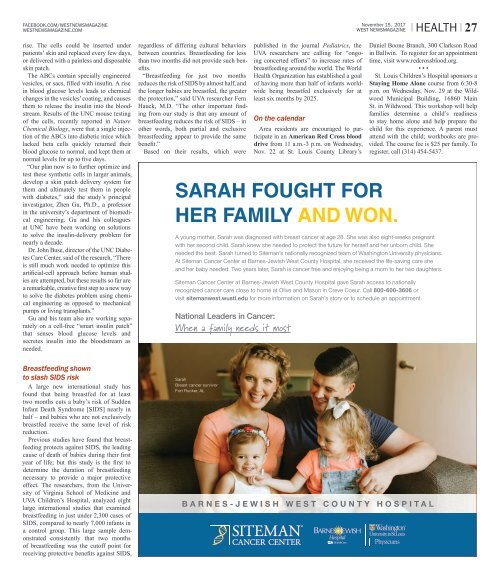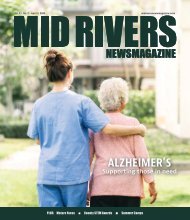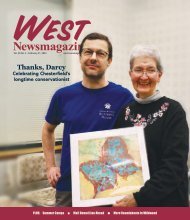West Newsmagazine 11-15-17
Local news, local politics and community events for West St. Louis County Missouri.
Local news, local politics and community events for West St. Louis County Missouri.
Create successful ePaper yourself
Turn your PDF publications into a flip-book with our unique Google optimized e-Paper software.
FACEBOOK.COM/WESTNEWSMAGAZINE<br />
WESTNEWSMAGAZINE.COM<br />
November <strong>15</strong>, 20<strong>17</strong><br />
WEST NEWSMAGAZINE<br />
I HEALTH I 27<br />
rise. The cells could be inserted under<br />
patients’ skin and replaced every few days,<br />
or delivered with a painless and disposable<br />
skin patch.<br />
The ABCs contain specially engineered<br />
vesicles, or sacs, filled with insulin. A rise<br />
in blood glucose levels leads to chemical<br />
changes in the vesicles’ coating, and causes<br />
them to release the insulin into the bloodstream.<br />
Results of the UNC mouse testing<br />
of the cells, recently reported in Nature<br />
Chemical Biology, were that a single injection<br />
of the ABCs into diabetic mice which<br />
lacked beta cells quickly returned their<br />
blood glucose to normal, and kept them at<br />
normal levels for up to five days.<br />
“Our plan now is to further optimize and<br />
test these synthetic cells in larger animals,<br />
develop a skin patch delivery system for<br />
them and ultimately test them in people<br />
with diabetes,” said the study’s principal<br />
investigator, Zhen Gu, Ph.D., a professor<br />
in the university’s department of biomedical<br />
engineering. Gu and his colleagues<br />
at UNC have been working on solutions<br />
to solve the insulin-delivery problem for<br />
nearly a decade.<br />
Dr. John Buse, director of the UNC Diabetes<br />
Care Center, said of the research, “There<br />
is still much work needed to optimize this<br />
artificial-cell approach before human studies<br />
are attempted, but these results so far are<br />
a remarkable, creative first step to a new way<br />
to solve the diabetes problem using chemical<br />
engineering as opposed to mechanical<br />
pumps or living transplants.”<br />
Gu and his team also are working separately<br />
on a cell-free “smart insulin patch”<br />
that senses blood glucose levels and<br />
secretes insulin into the bloodstream as<br />
needed.<br />
regardless of differing cultural behaviors<br />
between countries. Breastfeeding for less<br />
than two months did not provide such benefits.<br />
“Breastfeeding for just two months<br />
reduces the risk of SIDS by almost half, and<br />
the longer babies are breastfed, the greater<br />
the protection,” said UVA researcher Fern<br />
Hauck, M.D. “The other important finding<br />
from our study is that any amount of<br />
breastfeeding reduces the risk of SIDS – in<br />
other words, both partial and exclusive<br />
breastfeeding appear to provide the same<br />
benefit.”<br />
Based on their results, which were<br />
published in the journal Pediatrics, the<br />
UVA researchers are calling for “ongoing<br />
concerted efforts” to increase rates of<br />
breastfeeding around the world. The World<br />
Health Organization has established a goal<br />
of having more than half of infants worldwide<br />
being breastfed exclusively for at<br />
least six months by 2025.<br />
On the calendar<br />
Area residents are encouraged to participate<br />
in an American Red Cross blood<br />
drive from <strong>11</strong> a.m.-3 p.m. on Wednesday,<br />
Nov. 22 at St. Louis County Library’s<br />
Daniel Boone Branch, 300 Clarkson Road<br />
in Ballwin. To register for an appointment<br />
time, visit www.redcrossblood.org.<br />
• • •<br />
St. Louis Children’s Hospital sponsors a<br />
Staying Home Alone course from 6:30-8<br />
p.m. on Wednesday, Nov. 29 at the Wildwood<br />
Municipal Building, 16860 Main<br />
St. in Wildwood. This workshop will help<br />
families determine a child’s readiness<br />
to stay home alone and help prepare the<br />
child for this experience. A parent must<br />
attend with the child; workbooks are provided.<br />
The course fee is $25 per family. To<br />
register, call (314) 454-5437.<br />
Breastfeeding shown<br />
to slash SIDS risk<br />
A large new international study has<br />
found that being breastfed for at least<br />
two months cuts a baby’s risk of Sudden<br />
Infant Death Syndrome [SIDS] nearly in<br />
half – and babies who are not exclusively<br />
breastfed receive the same level of risk<br />
reduction.<br />
Previous studies have found that breastfeeding<br />
protects against SIDS, the leading<br />
cause of death of babies during their first<br />
year of life; but this study is the first to<br />
determine the duration of breastfeeding<br />
necessary to provide a major protective<br />
effect. The researchers, from the University<br />
of Virginia School of Medicine and<br />
UVA Children’s Hospital, analyzed eight<br />
large international studies that examined<br />
breastfeeding in just under 2,300 cases of<br />
SIDS, compared to nearly 7,000 infants in<br />
a control group. This large sample demonstrated<br />
consistently that two months<br />
of breastfeeding was the cutoff point for<br />
receiving protective benefits against SIDS,

















